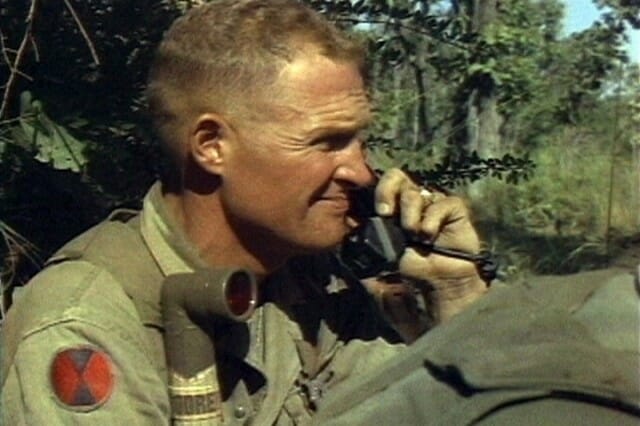On the wall above my desk, a print hangs as reminder of the true meaning of the steady hand of leadership. The print, First Boots on the Ground, depicts a moment in time just before 11:00 AM on the morning of November 14, 1965, as Lieutenant Colonel Hal Moore leads a group of 1st Cavalry Division troopers away from a UH-1 helicopter and into the tall grass of a quiet landing zone at the foot of the Chu Pong massif above the Ia Drang river valley. Tasked with leading a “search and destroy” mission into a remote stretch of jungle not far from the Ho Chi Minh trail, the initial elements of Moore’s 1st Battalion, 7th Cavalry touched down in Landing Zone X-Ray unsure of what they would find. Within thirty minutes, the battalion would be engaged in a fight for their lives, facing a regiment of North Vietnamese regular army troops and outnumbered ten to one.
What history remembers as the Battle of the Ia Drang Valley represents one of the most studied events of the Vietnam War. The Ia Drang was America’s first significant trial by fire in the war, but it would not be the last. In the chaos that is the heat of battle, Moore was the calm in the eye of the storm. What could have ended in tragedy instead became a story of triumph. Despite seemingly insurmountable odds, the battalion prevailed in a fierce battle of wills, with Hal Moore emerging as the epitome of battlefield leadership. During the day and night that followed on LZ X-Ray, he proved to be everything anyone could hope for from a leader in a time of crisis, as well as a model for what “right” looks like when faced with what may seem like an unwinnable battle.
Presence.
Nothing provides stability in times of crisis like a visible leader. Conversely, nothing destabilizes an organization in crisis more than a lack of leadership. During the Battle of the Ia Drang Valley, Moore was present and visible. His energy, focus, and force of will set the tone for the battle and gave his troops the confidence that won the day.
In a crisis, it’s not always possible for a leader to be physically present at every juncture. Maintaining effective presence is more than just the physical act of being present. It’s ensuring that your people know that you’re where you need to be when you’re needed most. It’s providing clear guidance and intent. It’s taking measures to delegate the right tasks to the right people. That ensures that your presence is felt even in your absence.
Focus.
Shortly after the publication of We Were Soldiers Once… and Young, Terry Gross of National Public Radio interviewed Moore. When describing his focus during the battle, Moore stated, “… you cannot impart, by your very manner and your voice on the radio, any possible sign or word or tone of voice that would indicate to any listener or any of your men looking at you that you were rattled. You had to look cool and be cool.” Even with the storm brewing around him, he had to stay focused and calm. Not an easy task when the bullets are flying.
When a crisis descends, an effective leader has to stay in the moment; yesterday is gone, tomorrow isn’t here, yet. Focus on what can be done in the moment, not what you wish you would have done or what you might do later. Stay grounded. Keep your emotions in check. Prioritize what’s possible and focus on that. That sense of focus and calm is contagious, just as are panic and hysterics.
Decisiveness.
Nothing inspires a lack of confidence quite like an indecisive leader in a moment of crisis. This was not Moore. In the midst of being overrun by North Vietnamese regular army forces, his ability to make critical decisions under duress saved countless lives. He personally maneuvered his men to counter enemy attacks in the moment, choosing where, when, and how to engage his adversary. He managed the fight in time and space, deciding where to focus fires and how best to use them to advantage. And, when the battle reached a crucial tipping point, he didn’t hesitate to initiate Broken Arrow, a radio call that released every available combat aircraft to support the fight on LZ X-Ray.
Moore’s decisiveness set him apart as a leader. In times of crisis, the effectiveness of a leader is often measured in terms of their ability to make key decisions. In the heat of battle, that typically means being able to make qualitatively better decisions faster than your opponent. For other crisis leaders, that translates to an ability to make timely decisions with the best information available to you in the moment. Right or wrong, a leader makes decisions when it matters most rather than waiting for the situation to resolve itself or someone else to make the decisions for them.
Resolve.
Simply put, a crisis is a battle of wills. In the Battle of the Ia Drang Valley, Moore resolved to win the day. Throughout a fight as intense and volatile as any during the length of the war, he refused to succumb to defeat. His will prevailed over that of his opponent, a fact that was not lost on the North Vietnamese in the aftermath of the battle.
A crisis situation is not for the faint of heart. Typically, a crisis will present a complex array of dilemmas, each bearing a unique set of risks and potential pitfalls. Pulling “victory from the jaws of defeat” requires a leader with an indomitable strength of will, an uncommon resolve. In the words of former British Prime Minister Margaret Thatcher, a crisis “is no time to go wobbly.”




